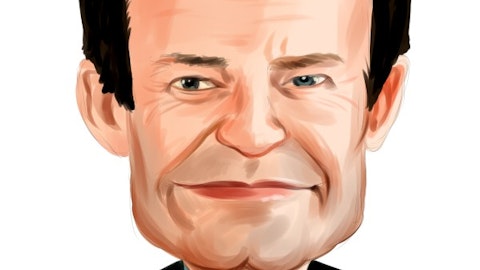Southside Bancshares, Inc. (NASDAQ:SBSI) Q1 2023 Earnings Call Transcript April 25, 2023
Southside Bancshares, Inc. beats earnings expectations. Reported EPS is $0.83, expectations were $0.79.
Operator: Good day, ladies and gentlemen, and thank you for standing by. Welcome to Southside Bancshares, Incorporated First Quarter 2023 Earnings Conference Call. At this time, all participants are in a listen-only mode. After the speakers’ presentation, there will be a question-and-answer session. At this time, I would like to turn the conference over to Ms. Lindsey Bailes, Vice President of Investor Relations. Ms. Bailes, please begin.
Lindsey Bailes: Thank you, Howard. Good morning, everyone, and welcome to Southside Bancshares’ first quarter 2023 earnings call. A transcript of today’s call will be posted on southside.com under Investor Relations. During today’s call and other disclosures and presentations, I will remind you that any forward-looking statements are subject to risks and uncertainties. Factors that could materially change our current forward-looking assumptions are described in our earnings release and our Form 10-K. Joining me today are Lee Gibson, President and CEO; and Julie Shamburger, CFO. First, Lee will share his comments on the quarter and then Julie will give an overview of our financial results. I will now turn the call over to Lee.
Lee Gibson: Good morning, everyone, and welcome to Southside Bancshares’ first quarter earnings call for 2023. This morning, we reported net income of $26 million, earnings per share of $0.83, a return on average assets of 1.38%, a return on average tangible common equity of 19.36% and continued strong asset quality metrics. On a linked quarter basis, our loan growth was less than originally anticipated. This was due to anticipated first quarter loan closing delays now expected to close in the second quarter and a few payoffs. During the quarter, we also lost loan opportunities due to our underwriting requiring lower leverage than our competitors. That said, we have no plans to change our time tested credit underwriting standards.
Because of our healthy pipeline, loans we anticipate funding during the second quarter projected construction loan advances and the markets we serve, we are still budgeting for overall loan growth for 2023 in the high-single digits. Increased competition for deposits largely accounted for the 19 basis point decrease in our net interest margin. Pricing competition from both financial institutions and U.S. Treasury Bills required us to adjust our pricing more than originally anticipated. Additionally, as uncertainty in the banking industry unfolded, we implemented measures to further enhance our already very solid liquidity position by maintaining additional cash at Fed at a very small spread and pledging additional securities at Fed increasing availability there.
Solely to enhance our interest rate risk profile, we utilized the Fed’s new bank term funding program, and as of yesterday, had obtained $287 million of one-year term funding at an average rate of 4.47% and our discretion can be re-priced or repaid at any time without penalty. We anticipate the net interest margin will continue to be pressured as competition for deposits remains high. Our interest rate swaps and fair value swaps continue to provide a hedge to offset a portion of the potential margin compression. Linked quarter deposits, net of brokered and public fund deposits decreased 3.4% during the quarter, 78% of which occurred prior to the banking industry events in early March. Over half of the decline in our total deposits linked quarter was a result of changing a portion of our swap funding from brokered deposits to lower cost fed borrowings resulting in $192 million reduction in brokered deposits.
Given the recent banking events, I think it’s important to point out that as of March 31, 2023, 73.5% of our deposits, our FDIC insured are fully collateralized. In addition, the average balance of our granular deposit account base is only $30,000. While we are keeping a watchful eye on the economy as more economists forecast increasing chances of a recession, we are glad to report that the markets we serve remain healthy and continue to grow. I look forward to answering your questions following Julie’s remarks, and I will now turn the call over to Julie.

Julie Shamburger: Thank you, Lee. Good morning, everyone, and welcome to our call today. We are pleased to report a solid start to 2023 with first quarter net income of $26 million and diluted earnings per common share of $0.83, a decrease of $0.04 or 4.6% linked quarter. Net income decreased by $1.6 million or 5.9%, driven by a decrease in net interest income, partially offset by a decrease in provision for credit losses. In light of events occurring in the banking industry since March, we included several additional disclosures in our earnings release, which showed the granularity of our deposit base with an overall average balance of $30,000 well below FDIC insurance levels. We estimate an insured deposits of 26.5% as of March 31 with the exclusion of public funds, which are fully collateralized in Southside owned deposits.
Deposits decreased $359.8 million or 5.8% on a linked quarter basis. Over half of the decrease was due to our brokered deposits of $191.8 million as we transitioned some of our funding of cash flow hedge swaps to more advantageous funding sources. The remaining decrease in deposits was related primarily to customer non-maturity deposits with a large percentage of the outflow occurring prior to March as mentioned in our earnings release. Our loan portfolio remained consistent at $4.15 billion linked quarter, and the weighted average rate of new loans funded during the quarter was approximately 6.97%. We reported strong asset quality metrics this quarter with non-performing assets of $3.2 million or 0.04% of total assets at March 31, a decrease of $7.7 million linked quarter, primarily related to the adoption of an accounting pronouncement around the recognition and measurement of troubled debt restructures.
At March 31, our allowance for loan losses as a percentage of total loans was 0.87%, a slight decrease compared to 0.88% on December 31. Our allowance for credit losses decreased $311,000 for the linked quarter. As of March 31, our loans with oil and gas industry exposure were $109.2 million or 2.6% of total loans. Our securities portfolio increased $119.9 million or 4.6% on a linked quarter basis. The first quarter increase was driven by purchases of three month treasury bills partially offset by sales of AFS securities. The sales of the AFS securities resulted in a net realized loss of $2.1 million, which was more than offset by the sale of equity securities that resulted in a net gain of $2.4 million. There were no transfers of AFS securities during the first quarter.
At March 31, we had a net unrealized loss in the AFS securities portfolio of $61.9 million compared to $88.9 million last quarter, a decrease of $27 million. As of March 31, the unrealized gain on the hedged securities was approximately $9.8 million, partially offsetting the unrealized losses in the AFS securities portfolio. As of March 31, the duration in the entire securities portfolio was 8.9 years, and the duration of the AFS portfolio was 6.6 years. Our mix of loans in securities slightly shifted to 60% and 40%, respectively compared to 61% and 39% at December 31. Our capital ratios remain strong with all capital ratios well above the capital adequacy and well capitalized thresholds. Liquidity resources remain solid with $1.9 billion in liquidity lines available as of March 31.
During the first quarter, we purchased 457,394 shares of our common stock at an average price per share of $34.89. Since quarter end and through April 20, we have purchased 177,406 shares at an average price of $33.02. Our tax equivalent net interest margin decreased on a linked quarter basis to 3.21 from 3.40 driven by the average yield and the average balance on interest-bearing liabilities partially offset by an increase in the average yield on earning assets. The tax equivalent net spread decreased for the same period by 33 basis points to 2.62, down from 2.95. For the three months ended March 31, net interest income decreased $3.5 million or 6.1% compared to the linked quarter. We also recorded $88,000 in purchase loan accretion this quarter.
Non-interest income, excluding the net gain on the sales of the AFS securities and equity securities increased $997,000 or 9.3% for the linked quarter. The increase was driven by BOLI income related to death benefits of $951,000 realized in the first quarter. For the same three-month period, non-interest expense was $34.8 million, an increase from the prior quarter of $1.3 million or 3.8%, primarily related to an increase in salaries and employee benefits. For 2023, we have budgeted approximately $35.5 million in non-interest expense each quarter. Our fully taxable equivalent efficiency ratio increased to 50.99% as of March 31 from 46.38% as of December 31, driven by the decrease in net interest income and increase in non-interest expense. Income tax expense increased to $4.5 million compared with $4.3 million for the three months ended December 31.
Our effective tax rate increased to 14.9% for the first quarter from 13.4% in the previous quarter. At this time, we estimate an annual effective tax rate of 14.9% for 2023. Thank you for joining us today. This concludes our comments and we will open the line for your questions.
See also 16 Best Utility Stocks to Buy Now and 15 Biggest SaaS Companies in the World.
Q&A Session
Follow Southside Bancshares Inc (NASDAQ:SBSI)
Follow Southside Bancshares Inc (NASDAQ:SBSI)
Operator: Our first question or comment comes from the line of Brett Rabatin from Hovde Group. Mr. Rabatin, your line is open.
Brett Rabatin: Hey. Good morning, everyone.
Lee Gibson: Good morning.
Brett Rabatin: Wanted to first ask, you obviously reduced the duration on the securities portfolio linked quarter with the movements. Can you just talk – can we go back over just what you bought and sold during the quarter, and then just does that yield on that portfolio? What the matriculation on the securities book might be from here from a yield perspective?
Lee Gibson: Okay. We sold primarily municipal securities and some mortgage-backed securities. And then in terms of purchases, it was largely the T-bills that we purchased. I think that when we look at the duration, we also take a look at the duration of our fair value swaps, and we didn’t include that in that duration calculation that Julie mentioned. But if we were to include that and take a look at the real duration risk that we have with the fair value swaps in place, it drops it to just under 4% – I mean four years – not 4%, four years. So going forward, obviously the T-bills will roll-off this quarter, so that’s approximately $300 million. And then we’ll have some additional things roll-off, but that’s not going to be substantial in nature what is going to roll off.
Brett Rabatin: Okay.
Lee Gibson: But one thing that the one – and then I want to point out that the fair value swaps also right now are adding a little over a $1 million in net interest income to the overall securities income.
Brett Rabatin: Okay. And then maybe just any outlook for the margin from here. I’m curious how you think about the deposit betas from current levels. The funding costs have been managed pretty well. But some folks are expecting an uptick. Just curious, Julie, how you feel about the margin from 1Q levels?
Lee Gibson: I think, as I said, I think it’s going to continue to be pressured. Competition for deposits was already pretty intense in the first quarter. And then with the events that occurred in early March with the closures of a couple of banks that intensified even further. So we don’t expect that to change anytime soon and we expect competition for deposits to remain very intense and growing deposits would be an expensive proposition at this point in time.
Brett Rabatin: Okay. And then the other question I had, Lee, was you mentioned high single-digit loan growth from here or maybe that’s for the full-year. I wasn’t quite sure what that guidance was, so I apologize, I may have misunderstood that. But just I want to make sure I understood that. And then if that’s a function of – you talked about how you were missing some deals due to your credit stringent nature, and maybe that might have an impact on what you get versus what you don’t, but just wanted to maybe get a little better color on the guidance. If that entails, you think the market comes back to you in terms of loan underwriting standards, or if you just feel like there’s stuff out there that you’ll be able to get as others pull back on credit?
Lee Gibson: We’re still winning loan deals. It’s just that this quarter was a little unusual in that we really hadn’t seen leverage requirements come into play in turn – usually it was rate driven. This quarter we did see some deals that we required a lower leverage than competition did, and we’re never concerned when we lose loans based on leverage. But the guidance, I gave was for the entire year of 2023, we’re still anticipating when you look at the end of 2022 and you look at the end of 2023 that based on what we know today and our pipeline that we’re still anticipating high single-digit loan growth for the entire year of 2023.
Brett Rabatin: Okay. Great. Appreciate all the color.
Operator: Thank you. Our next question or comment comes from the line of Brady Gailey from KBW. Standby. Mr. Gailey, your line is open.
Brady Gailey: Hey. Thank you. Good morning, guys.
Lee Gibson: Good morning, Brady.
Julie Shamburger: Good morning.




